"In the depth of winter I finally learned that there was in me an invincible summer." -Albert Camus
As the year draws to a close, we approach a very special time of year, at least from an astronomical perspective. This Saturday, December 21st, will mark the Winter Solstice in the Northern Hemisphere (or the Summer Solstice in the Southern), or the date where the Earth's axis is tilted its maximal amount away from (or towards) the Sun, as viewed from an observer in the Northern (or Southern) Hemisphere.
While it's pretty common knowledge that the Earth's revolution around the Sun in conjunction with its axial tilt is the reason for the seasons, the December solstice -- one of the two days where the Earth's tilt is maximally inclined with respect to the Sun -- brings a number of special things along with it. (Please note that all latitude-dependent ones apply equally to the Southern Hemisphere on the June solstice!)
Here are my top six.
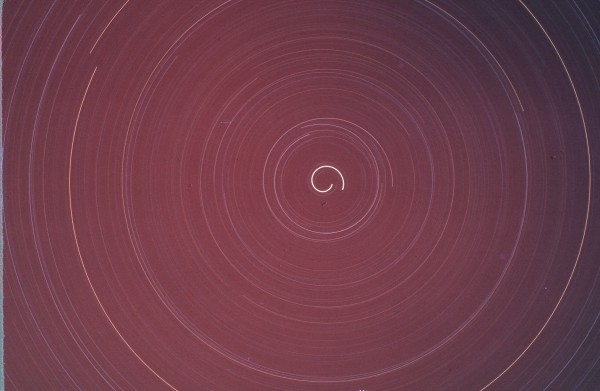 Image credit: Earl Moser, via http://www.astro-tom.com/.
Image credit: Earl Moser, via http://www.astro-tom.com/.
1.) A dedicated astrophotographer living North of the Arctic Circle could take the first-ever 360-degree star trail photo!
Never-yet-accomplished, Lewin's Challenge requires 24 hours of consecutive darkness, something that happens for six continuous months centered on the solstices at each of the poles. As we cycle through our orbit, the equinoxes mark a time when every location on Earth receives 12 hours of daylight and 12 hours of night. Subsequently, one of the poles plunges into darkness, with progressively lower and lower (numbered) latitudes surrounding that pole joining the party. This reaches its peak on the Solstice, where all latitudes within 23.5 degrees of the pole-in-darkness (so everyone north of 66.5 degrees on Saturday's Solstice) will receive 24 hours of continuous darkness.
If you can get there and leave your shutter open, properly centered on the North Pole, you could be the first one! Anyone in Utsjoki, Finland, want to give it a shot? And speaking of latitude...
2.) Anyone living north of the 43rd parallel will, on the Winter Solstice, never have the Sun rise higher in the sky than it appears all day at the South Pole!
That's right, the South Pole -- one of our favorite metaphors for a cold, dark, remote place -- will have the Sun be higher above the horizon all day than locations like Madison, WI, Portland, OR, all of Germany, Poland, England and nearly all of Russia will see at any time during the day!
In fact, for a modest location like Portland, OR, with a latitude of 45.6 degrees N, it will take around a week for the Sun to reach an angle above the horizon that exceeds what you'd see at the South Pole, and for an observer at the Arctic Circle, that won't happen for another six weeks!
3.) The Winter Solstice now occurs very close to perihelion, or the Earth's closest position to the Sun, but that is slowly changing over time!
The Earth's orbit around the Sun makes an almost perfect ellipse, making a complete revolution every year. Well, kind of. You see, there are two types of year: the tropical year, which we define as 365 (or sometimes 366) days, and is the amount of time it takes the Sun to return to the same position it was in the sky approximately one revolution ago, and the sidereal year, which is the amount of time it takes the Earth to return to the same location in space, relative to the Sun, that it was exactly one revolution ago.
These two measurements of years are slightly different from one another, by one part in about 26,000; combined with the smaller intrinsic precession of Earth's orbit with respect to the stars (mostly due to the other planets), we get that the Winter Solstice cycles through an entire orbit every 21,000 years. The Winter Solstice coincided with perihelion -- which now occurs just a couple of weeks later -- around 800 years ago, and has been progressively migrating away from it; in about 10,000 years, it will be coincident with aphelion, or the point of farthest distance from the Sun! Enjoy Saturday's Winter Solstice as the closest solstice to the Sun you'll ever experience for the rest of your life!
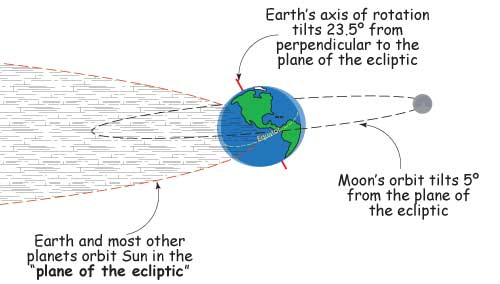 Image credit: NASA's Sci-jinks, via http://scijinks.jpl.nasa.gov/.
Image credit: NASA's Sci-jinks, via http://scijinks.jpl.nasa.gov/.
4.) The low position of the Sun in the sky means that the full Moon closest to the Solstice, at its highest, will be the highest full Moon above the horizon of the year!
Think about it; when the Earth's axis is maximally tilted towards the Sun and the Moon is full -- as in, on the other side of the Earth from the Sun -- that means the Earth's axis will be maximally tilted away from the Moon. (To within a maximum error of just 5 degrees, the amount that the Earth-Moon orbital plane is inclined to the Earth-Sun plane.) That means, in a broad sense, that just as the Sun appears to carve its lowest paths through the sky, the full Moons closest to your Winter Solstice carve their highest paths through the sky, and vice versa during the Summer Solstice!
So while Australians are enjoying the Sun riding its highest paths through the sky, here in the north we'll enjoy the nearly-full Moon doing the same thing!
5.) Solstice is Latin for "Sun stands still," and this is for a good reason!
For approximately a week in each direction around both solstices, the path of the Sun through the sky barely changes at all for all observers in both hemispheres. As such, our word for solstice marks exactly that occurrence, and explains why, if you track the Sun's path on a daily basis over the course of a year, you'll see nearly identical tracks near the bottom (marking the Winter Solstice) and the top (marking the Summer Solstice) of all such images.
And finally, as a historical fact, the Winter Solstice has an amazing significance for humanity as we long for the distant planets and stars.
6.) It was on the Winter Solstice in 1968 that humans, for the first time, were launched to the Moon!
The Apollo 8 mission, the first manned mission to reach and orbit the Moon, was launched on the Winter Solstice in 1968, exactly 45 years ago this Saturday. The first humans to ever see the Earth from such a great distance, Frank Borman, Jim Lovell and Bill Anders began their journey away from Earth on the Winter Solstice, the darkest evening of the year.
Three days later, they plunged behind the Moon, and Earth became invisible for a few hours. When those few hours passed, this was what they saw.
As Bill Anders said almost immediately,
"We came all this way to explore the Moon, and the most important thing is that we discovered the Earth."
So enjoy the solstice however you see fit, and as you do, remember -- whether you're bathed in the longest day or the longest night of the year -- that there are some things that bring us all together.

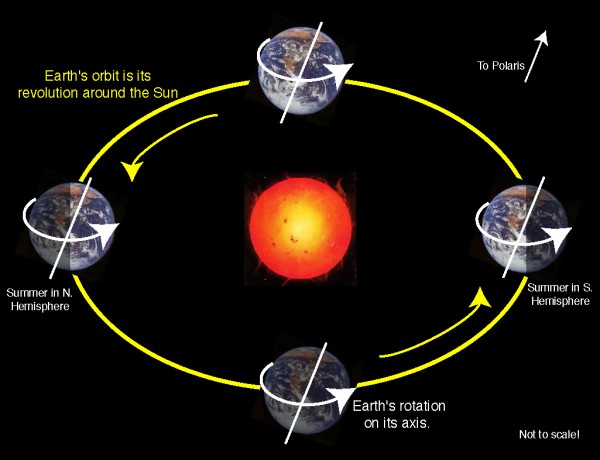
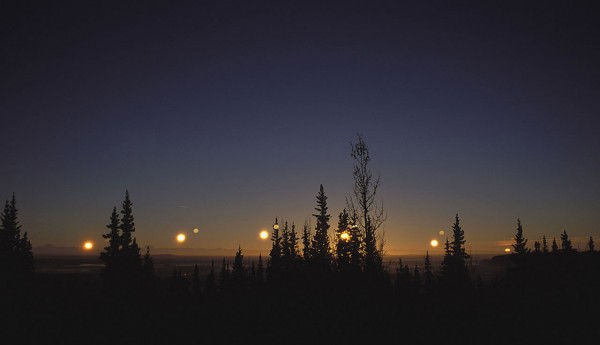
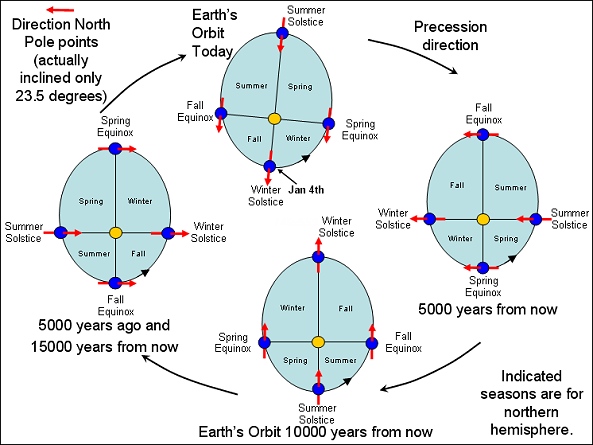


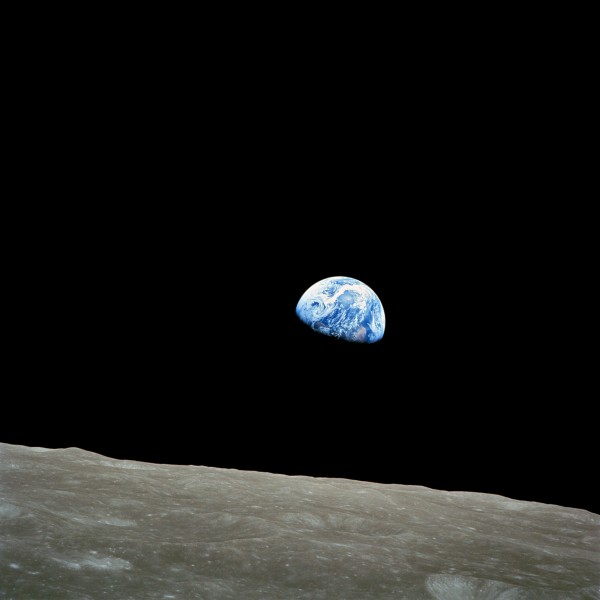
Umm.. I think aphelion is actually July 5th this year. Perihelion, or Earth's closest approach to the sun occurs January 2 at 4:48 UT.
LOL. You changed it already!
As your punishment for getting that wrong the first time, you must perform the calculus on the sun's angle for both winter solstice and summer solstice, taking into account the Sun-Earth distance to calculate the energy per square meter.
Never let me get away with proofreading my own post!
Actually the ecliptic plane is defined by Earth's revolution and "most" other planets are revolving around the sun in similar orientations. It is possible to measure and define the other planets "nodes" which are locations when the planets cross the ecliptic plane from south to north and north to south. These points are stationary in any local time frame but travel at a slow speed similar to the precession of the equinoxes around the plane. Thus in relation to the ecliptic, there are North or South latitudes for each planet and each planet's measure in right ascension is a merging of both latitude as here described and longitude pinpointed by projection to the ecliptic plane.
Actually right ascension is defined a bit more precisely and focusses on different aspects but the same point is defined both by the merging I describe here and the other system of measure that is right ascension.
slightly off topic but sun-related. (I've been away and am catching up on older posts. black holes, yay!)
I've read several times that the light made at the core of a sun like our own takes 50 million years to reach the surface. in essence, there's 50 million years of light "stored" in there. when a sun goes nova, I imagine those "trapped" photons get released at the rate of the explosive expansion of the core ... so in addition to the light "made" by the nova event itself, the catastrophe is accompanied by the 50 million years of light "stored up."
is this even remotely true?
~~~
more importantly, thank you so much for your "blog" (as a 60-year-old writer I really loathe that term). yours is not merely my favorite science blog, but my favorite blog. I don't understand why people think science is dry. you bring so much heart to it that you really make it poetry.
gratitude.
I am troubled by the fact that you have markes the first pic as "not to scale" ....thinking of the reasons that you had to do it just make me shiver....
@Ernest...its not really that long. I've seen figures ranging from 40,0000 to 1 million years. It depends on what assumptions you make for the density and opacity of the Sun at different layers.
KC,
I don't have a dog in this race (and no assumptions about density or opacity), I have just often wondered if this light is part of why a nova is so brilliant. the notion seems reasonable, but I've never seen it expressed explicitly. this is a lot of light, and I would think descriptions of nova would mention it.
http://www.sciencerecorder.com/gallery/index.php?pageNum_show_selected_…
@Ernest Johns #73 et al: The description you quote "light made at the core of the sun takes 50 million years [or 40,000, or 1 million, or whatever] to get out" is true-ish, but a dreadful oversimplification :-)
What happens, as a result of the density and opacity of the matter around the core, is that the light is repeatedly absorbed by some nucleus, then, after some time, new light is emitted by that nucleus.
Since the successive emission events are uncorrelated with the prior absorption, the new photons may be going in the same direction, the opposite direction, or crosswise.
If you tried, in some computer model, to launch a photon from the "exact center of the Sun", and followed all of the successive interactions, then you would discover that the last emitted photon that got up to the photosphere appeared some thousands or N-hundred thousands of years after the original launch.
Does that clarify things for you, or just make it more confusing?
@Ernest #7, KC #9: Ironically, Ethan quoted a value for the emission time in his latest post on variable stars!
"This would be extremely unlikely, as the time it takes a typical photon generated in the core to reach the stellar surface is on the order of 100,000 years, "
I didn't see that until after my previous comment. It doesn't change my description at all, but does serve to give you a benchmark for the timescale involved.
thanks all for your efforts.
oddly, I wasn't asking about the escape time of a photon from a sun's core. I was asking if this light contributes significantly to the brightness of a star going nova (I've never seen this expressed explicitly). I ignored the mechanism of photon transmission through a hot gas as ancillary to my question. my limited understanding is that photons are absorbed by atoms at discrete energy levels, pushing electrons into outer orbits, from which they will eventually return (at discrete energies which we observe as discrete color bands by which we can identify the specific atoms comprising that star.). this suggests a "storage" mechanism for a lot of photons. I'm much happier with a number like 100,000 years than 50 million -- but both numbers are hugely counter-intuitive. I would be happy with a number like "one year."
yet energy to be released as photons remains stored in those gazillions of atoms with electrons in higher orbits.
is this light released during a nova and does it contribute to the brilliance of a nova for the days it dominates the luminance of its home galaxy? my nephew wants to know.
qualifying our query even a little more.
we suspect the answer is "yes." but we know it's not a certain "yes." it's possible the sun blows itself apart and expands in such a way that jostling an atom just right so that it releases a photon is less likely rather than more likely, in which case that 100,000 years of stored energy remains stored in atoms exploding into space retaining high-energy-orbit electrons.
alternatively, the circumstances that encourage atoms to release photons might be enhanced and a lot of light released over a short period of time.
we don't have an informed opinion, or a dog in this race, just our layman's question.
Nice job on the post, BUT a few discrepancies. " the equinoxes mark a time when every location on Earth receives 12 hours of daylight and 12 hours of night." Not so. If the poles have either 12 hours of dark or sunlight and they are a location on earth then... Several others I noticed but I am not trying to correct you or make any negativity. You put alot into this and it is quite nice. I enjoyed it. Thanks.
@christopher There is one planet that has an east and west pole so the description of ascension would have to be different fromulaicly would'nt it? Since lat. is east west.
@Ernest (several): The photons in the Sun's "core" (really, all but the outer 5 or 10% thickness) aren't being "stored". They get emitted, absorbed, and re-emitted continuously, as part of the ongoing fusion process.
There isn't any "stored energy" there to contribute to a nova -- that process emits all of its energy in the form of a combination collapse (adiabatic heating) and runaway fusion.
Also, your correct description of _atoms_ absorbing and emitting discrete wavelengths (spectral lines) only applies to neutral or nearly neutral atoms. The Sun is a fully ionized plasma -- it consists of completely bare nuclei swimming around in a vast sea of free electrons. Under those conditions, photons don't travel very far before they interact with the electrons. That's why it's opaque.
Michael, thank you for your kind, awesome, and informative comments. you have two fans here. I really appreciate this strange new technology (internet and blogs) that enable a budding young aficionado of science to communicate with real working scientists and engineers.
again, thank you for your kind consideration.
/Ernest & Nephew